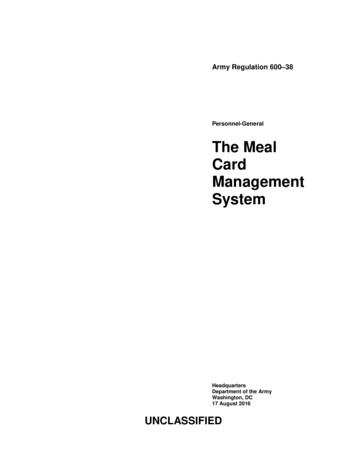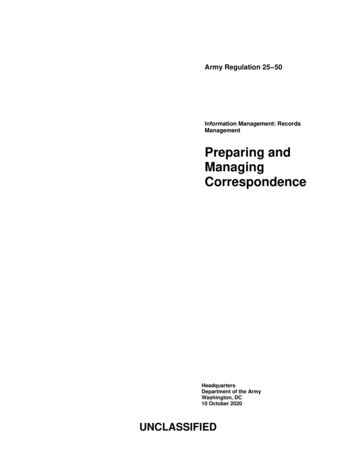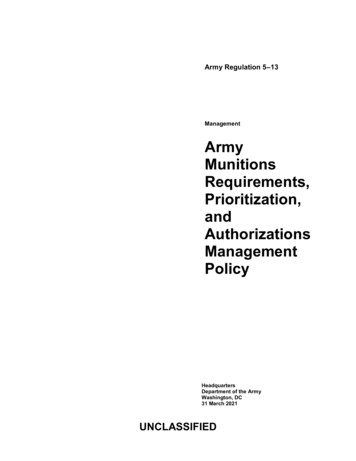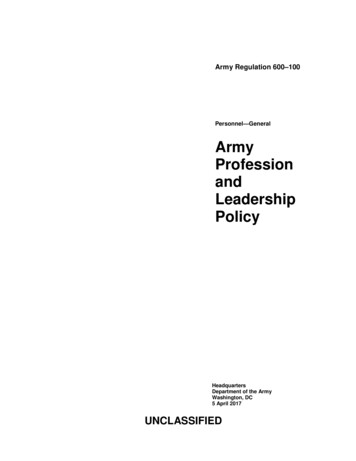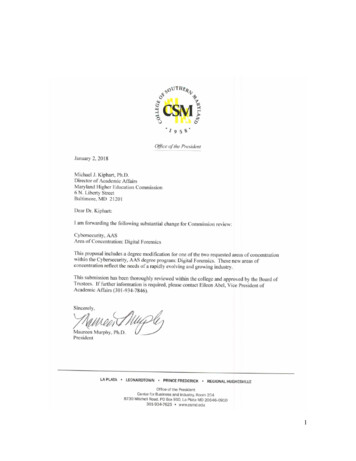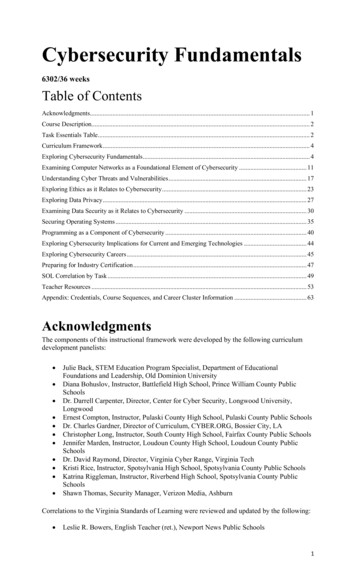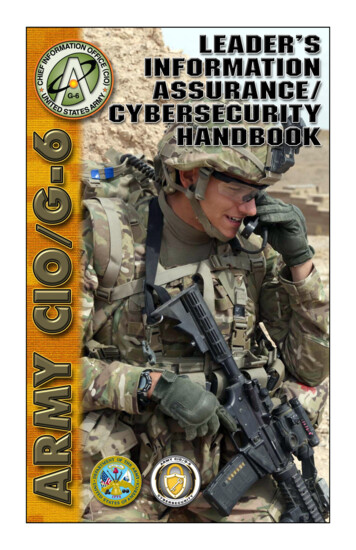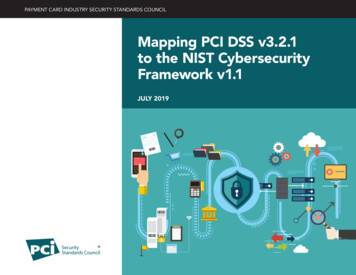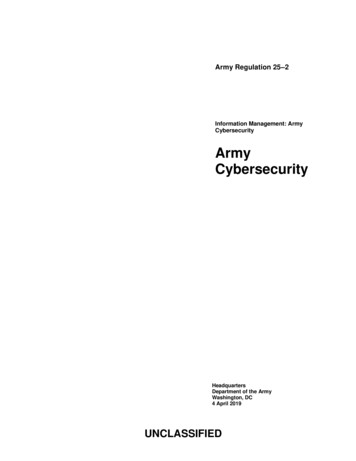
Transcription
Army Regulation 25–2Information Management: rtment of the ArmyWashington, DC4 April 2019UNCLASSIFIED
SUMMARY of CHANGEAR 25–2Army CybersecurityThis administrative revision, dated 30 May 2019—oCorrects the e-mail address (title page).oThis major revision, dated 4 April 2019—oChanges the title of the regulation from Information Assurance to Army Cybersecurity (cover).oPrescribes the use of DA Form 7789 (Privileged Access Agreement and Acknowledgement of Responsibilities) (paras2–1c(3) and 2–38a(3)).oAssigns responsibilities and prescribes policies for the Army Cybersecurity Program in accordance with DODI8500.01, DODI 8510.01, and related issuances listed in appendix A (throughout).oImplements functional elements of AR 525–2 as they relate to cyber risk management (throughout).oSupersedes Army Directive 2013–22, Implementation and Enforcement of the Army Information Assurance Program(hereby superseded) (throughout).oFully integrates cybersecurity into system life cycles and makes cybersecurity a visible element of informationtechnology portfolios (throughout).oImplements a standard, integrated, change management process for Army information technology across all missionand business areas to ensure efficient and secure handling of all changes to the Army’s information technologyinfrastructure, applications, systems, architecture, software, and hardware (throughout).oEnsures that information technology and resources (personnel, equipment, and training) support operational andenterprise objectives, and are consistent with applicable laws, regulations, and standards (throughout).oEnsures that mission-essential tasks for cybersecurity readiness are set, and assessment data are collected, processed(in an automated fashion, where possible), analyzed, reported, and continually monitored to ensure that correctiveactions are taken to address readiness issues (throughout).
HeadquartersDepartment of the ArmyWashington, DC4 April 2019*Army Regulation 25–2Effective 4 May 2019Information Management : Army CybersecurityArmy Cybersecuritypersonnel, authorized users and privilegedusers, unless otherwise stated. It applies toall Army information technology and information in electronic format at all classification levels; and Special Access Programand Sensitive Activity information systemsexcept when handling sensitive compartmented information. Nothing in this regulation alters or supersedes the existing authorities and policies of the Department of Defense or the Director of National Intelligence regarding the protection of sensitivecompartmented information as directed byExecutive Order 12333. The Director ofNational Intelligence has delegated authority for all Army Sensitive CompartmentedHistory. This publication is an adminis- Information systems to the Deputy Chief oftrative revision. The portions affected by Staff, G–2.this administrative revision are listed in theProponent and exception authority.summary of change.The proponent of this regulation is theSummary. This regulation establishes Army Chief Information Officer/G–6. Thethe Army Cybersecurity Program and sets proponent has the authority to approve exforth the mission, responsibilities, and poli- ceptions or waivers to this regulation thatcies to ensure uniform implementation of are consistent with controlling law and regpublic law and Office of Management and ulations. The proponent may delegate thisBudget, Committee on National Security approval authority, in writing, to a divisionSystems, and Department of Defense issu- chief within the proponent agency or its diances for protecting and safeguarding Army rect reporting unit or field operatinginformation technology, to include the agency, at the rank of O–6 or GS–15. AcArmy-managed portion of the Department tivities may request a waiver to this regulaof Defense Information Network, (hereafter tion by providing justification that includesreferred to as information technology) and a full analysis of the expected benefits andinformation in electronic format (hereafter risk. All waiver requests will be endorsedreferred to as information). Information by the commander or senior leader of thetechnology includes infrastructure, ser- requesting activity and forwarded throughvices, and applications used directly by the its higher headquarters to the policy propoArmy or for the Army by legal agreements nent. The request must include formal reor other binding contracts.view by the activity’s senior legal officerApplicability. This regulation applies to and endorsement by the authorizing offithe Regular Army, the Army National cial. Refer to AR 25–30 for specific guidGuard/Army National Guard of the United ance.States, and the U.S. Army Reserve, to in- Army internal control process. Thisclude all Headquarters, Department of the regulation contains internal control proviArmy staff, Army commands, Army Ser- sions, in accordance with AR 11–2, andvice component commands, direct report- identifies key internal controls that must being units, all other Army agencies, and all evaluated (see appendix B).Supplementation. Supplementation ofthis regulation and establishment of command and local forms are prohibited without prior approval from the Army Chief Information Officer/G–6 (SAIS– CB), g6.policyinbox@mail.mil).Suggested improvements. Users areinvited to send comments and suggestedimprovements on DA Form 2028 (Recommended Changes to the Publications andBlank Forms) directly to Army Chief Information Officer/G–6 (SAIS–CB), 107 ArmyPentagon, Washington, DC y-inbox@mail.mil).Committee management. AR 15–39requires the proponent to justify establishing or continuing committee(s), to coordinate draft publications, and to coordinatechanges in committee status with the Officeof the Administrative Assistant to the Secretary of the Army, Department of theArmy Committee Management Office(AARP–ZA), 9301 Chapek Road, Building1458, Fort Belvoir, VA 22060–5527. Further, if it is determined that an established“group” identified within this regulationlater takes on the characteristics of a committee, as found in AR 15–39, then the proponent will follow all AR 15–39 requirements for establishing and continuing thegroup as a committee.Distribution. This publication is available in electronic media only and is intendedfor the Regular Army, the Army NationalGuard/Army National Guard of the UnitedStates, and the U.S. Army Reserve.Contents (Listed by paragraph and page number)*This regulation supersedes AR 25-2, dated 24 October 2007 and AD 2013-22, dated 28 October 2013.AR 25–2 4 April 2019UNCLASSIFIEDi
Contents—ContinuedChapter 1Introduction, page 1Purpose 1–1, page 1References 1–2, page 1Explanation of abbreviations and terms 1–3, page 1Responsibilities 1–4, page 1Records management requirements 1–5, page 1Overview 1–6, page 1Statutory authority 1–7, page 1Precedence 1–8, page 1Chapter 2Responsibilities, page 2Principal Officials, Headquarters, Department of the Army; Commanders of Army commands, Army service componentcommands, and direct reporting units; and senior leaders of agencies and activities 2–1, page 2Assistant Secretary of the Army (Acquisition, Logistics, and Technology) 2–2, page 4Assistant Secretary of the Army (Financial Management and Comptroller) 2–3, page 5Assistant Secretary of the Army (Installations, Energy and Environment) 2–4, page 5Assistant Secretary of the Army (Manpower and Reserve Affairs) 2–5, page 5Administrative Assistant to the Secretary of the Army 2–6, page 5Army Chief Information Officer/G–6 2–7, page 5The Inspector General 2–8, page 7Army Auditor General 2–9, page 8Deputy Chief of Staff, G–1 2–10, page 8Deputy Chief of Staff, G–2 2–11, page 8Deputy Chief of Staff, G–3/5/7 2–12, page 9Deputy Chief of Staff, G–4 2–13, page 9Deputy Chief of Staff, G–8 2–14, page 10Assistant Chief of Staff for Installation Management 2–15, page 10Provost Marshal General 2–16, page 10Commanders of Army commands, Army service component commands, and direct reporting units, and senior leaders ofagencies and activities 2–17, page 10Commanding General, U.S. Army Training and Doctrine Command 2–18, page 10Commanding General, U.S. Army Materiel Command 2–19, page 11Commanding General, U.S. Army Cyber Command 2–20, page 11Commanding General, U.S. Army Intelligence and Security Command 2–21, page 12Commanding General, U.S. Army Test and Evaluation Command 2–22, page 13Commanding General, U.S. Army Criminal Investigation Command 2–23, page 13Army senior information security officer 2–24, page 13Authorizing official 2–25, page 14Authorizing official designated representative 2–26, page 14Security control assessor 2–27, page 14Information system owner 2–28, page 15Program and system managers 2–29, page 15Information system security officer 2–30, page 15Information system security manager 2–31, page 15Information system security engineer 2–32, page 15User representative 2–33, page 16All personnel 2–34, page 16Army-appointed authorizing officials 2–35, page 16Army code signing attribute authority 2–36, page 16Authorized users 2–37, page 16Privileged users and accounts 2–38, page 17Chapter 3The Army Cybersecurity Program, page 17iiAR 25–2 4 April 2019
Contents—ContinuedCybersecurity Program functions 3–1, page 17Cybersecurity governance activities 3–2, page 18Governance structure 3–3, page 19Army Cybersecurity governance 3–4, page 20Chapter 4Cybersecurity Risk Management Program, page 21Army Risk Management Program 4–1, page 21Cyber risk management 4–2, page 21Risk Management Framework 4–3, page 21Continuity of operations 4–4, page 22Physical security 4–5, page 22Information security 4–6, page 23Communications security 4–7, page 23Telecommunications Electronics Materiel Protected from Emanating Spurious Transmissions 4–8, page 23Operations security 4–9, page 23Protection of information technology and information 4–10, page 23Access control 4–11, page 24System and services acquisition 4–12, page 25Software assurance 4–13, page 26Cross-domain solutions 4–14, page 26Identity, credential, and access management 4–15, page 26Mobility 4–16, page 26Monitoring 4–17, page 27Configuration management 4–18, page 27Incident response and reporting 4–19, page 27Media security 4–20, page 27Internet and commercial cloud service providers 4–21, page 28Wireless services 4–22, page 28Peripheral devices 4–23, page 28Teleworking security 4–24, page 28Privately owned information technology 4–25, page 29Workforce management, training, education, and certification 4–26, page 29Chapter 5Acceptable Use, page 29User agreement 5–1, page 29User responsibilities and rules of behavior 5–2, page 30Notice of privacy rights and authorized monitoring and searches 5–3, page 30Chapter 6Compliance, page 30Oversight and inspections 6–1, page 30Compliance reporting requirements 6–2, page 31AppendixesA. References, page 32B. Internal Control Evaluation, page 41Figure ListFigure 3–1: Tiered risk management approach (NIST SP 800–39), page 19Figure 3–2: Army cybersecurity governance, page 20GlossaryAR 25–2 4 April 2019iii
Chapter 1Introduction1 –1. PurposeThis regulation establishes policies and assigns responsibilities for the Army Cybersecurity Program to ensure adherenceto Department of Defense (DOD) cybersecurity policies, processes, and standards. It integrates and coordinates with thefunctional elements of AR 525–2 to safeguard Army assets. The cybersecurity program sets the conditions necessary forthe Army to protect and safeguard information technology (IT) capabilities; support mission readiness and resilience; andensure the confidentiality, integrity, and availability of information in electronic format (hereafter referred to as information). It fully integrates risk management into every aspect of the Army.1 –2. ReferencesSee appendix A.1 –3. Explanation of abbreviations and termsSee the glossary.1 –4. ResponsibilitiesSee chapter 2 for responsibilities.1 –5. Records management requirementsThe records management requirement for all record numbers, associated forms, and reports required by this regulation areaddressed in the Records Retention Schedule-Army (RRS–A). Detailed information for all related record numbers, forms,and reports are located in Army Records Information Management System (ARIMS)/RRS–A athttps://www.arims.army.mil. If any record numbers, forms, and reports are not current, addressed, and/or published correctly in ARIMS/RRS–A, see DA Pam 25–403 for guidance.1 –6. OverviewCybersecurity is a holistic program to manage IT-related security risk. To be effective, it must be integrated fully intoevery aspect of the Army. It requires the implementation and enforcement of proper management and operational procedures by the entire organization, from commanders and senior leaders of agencies and activities providing the strategicvision and goals for the organization, to strategic planners and project and program managers (PMs), down to each individual who helps develop, implement, and operate the IT that supports the Army’s mission and business processes. Furthermore, each individual, at every level, is responsible for procedural compliance with the proper practices and proceduresfor safeguarding information and IT. The responsibility for ensuring that personnel abide by these practices and proceduresis inherent to commanders and senior leaders of agencies and activities.1 –7. Statutory authorityStatutory authority is derived from Section 2223, Title 10, United States Code (10 USC 2223); 40 USC 11315; 44 USC,Chapter 35; and applicable Office of Management and Budget (OMB) memoranda, to include reporting requirementsestablished via the Federal Information Security Modernization Act (FISMA) of 2014, Defense authorization and appropriations acts, and DOD issuances.1 –8. PrecedenceThis regulation is the proponent policy document for the Army Cybersecurity Program, which implements the DOD Cybersecurity Program. The Army will follow Director of National Intelligence (DNI), DOD, and Chairman of the JointChiefs of Staff (CJCS) issuances, to include directives, instructions, security technical implementation guides (STIGs),security requirements guides (SRGs), orders, and alerts. Supporting Department of the Army (DA) pamphlets will bepublished to provide uniform procedures for implementing and enforcing the policies in this regulation. Compliance withthis regulation and the supporting DA pamphlets is mandatory. When needed, the Army Chief Information Officer/G –6(CIO/G–6) will issue policy memoranda to amplify guidance for the policies in this document. This document does notalter or supersede existing DOD or DNI authorities and policies regarding the protection of sensitive compartmented information (SCI) and Special Access Programs (SAP) for intelligence, as directed by EO 12333, and national securityAR 25–2 4 April 20191
information systems, as directed by EO 13231, nor other applicable laws and regulations. The DNI has delegated authorityfor all Army SCI systems to the Deputy Chief of Staff (DCS), G–2. If at any time there is a conflict in this regulation withany related DNI, DOD, or Joint issuances, the higher-level policy will take precedence. Report identified conflicts or theneed for amplifying guidance on DA Form 2028 (Recommended Changes to Publications and Blank Forms).Chapter 2ResponsibilitiesCommanders and senior leaders of agencies and activities at all levels and those they appoint, to include PMs, informationsystem owners (ISOs), application owners, IT service owners, information owners, portfolio managers, resource managers,and acquisition senior and functional services managers, are accountable for the implementation and enforcement of thisregulation and will ensure individual and organization accountability within organizations and activities under their purview.2 –1. Principal Officials, Headquarters, Department of the Army; Commanders of Army commands,Army service component commands, and direct reporting units; and senior leaders of agencies andactivitiesHQDA Principal Officials; Commanders of ACOMs, ASCCs, and DRUs; and senior leaders of agencies and activitieswill—a. Implement the Army Cybersecurity Program to ensure that the personnel, processes, and IT for which they havedevelopment, procurement, integration, modification, operation and maintenance, and/or final disposition responsibilitycomply with this regulation and the amplifying policy guidance developed by the Army CIO/G–6. This includes, but isnot limited to—(1) Develop, maintain, and modify IT as required to ensure uniform application of cybersecurity policies, procedures,and standards, and risk management security controls, in accordance with OMB, National Institute of Standards and Technology (NIST), Committee on National Security Systems (CNSS), DOD, Joint, and Army issuances.(2) Develop, implement, and maintain the security plan for assigned IT, as described in DODI 8510.01.(3) Ensure that IT has been granted authorization to operate (ATO) by the assigned authorizing official (AO). Complywith all authorization decisions, including denial of authorization to operate. Enforce authorization termination dates.(4) Transition from legacy or end-of-life cross-domain solutions (CDS) to those on the CDS baseline list managed bythe Unified Cross-Domain Management Office (UCDMO).(5) When a cross-domain service is required, leverage those provided by the Defense Information Systems Agency(DISA) to the fullest extent possible.(6) Provide appropriate notice of privacy rights and explain monitoring policies to all users.(7) Require user authentication to DOD information systems and networks in accordance with DODI 8520.03.(8) Ensure an effective vulnerability management process is in place, which includes—(a) Ensuring that baseline configurations contain all required patches and follow applicable STIGs and SRGs at thetime the baseline is established, and are updated upon the release of new or revised information assurance vulnerabilityalerts, STIGs, and SRGs.(b) Ensure that security patches are made available for new vulnerabilities and are applied in accordance with the suspense dates or sooner if possible, per operational directives.(c) Employ an automated patching process, when practical, in order to minimize manpower requirements and systemdowntime.(d) Provide authorized personnel the access necessary to conduct required technical compliance assessments, to includevulnerability scans.(9) Provide for vulnerability mitigation and incident response and reporting capabilities in order to—(a) Comply in a timely and efficient manner with DOD and Army cybersecurity directives, guidance, and alerts forimplementing mitigations and taking corrective action in defense of the DOD information network (DODIN).(b) Limit damage and restore effective service following an incident.(c) Collect and retain audit data to support technical analysis relating to misuse, penetration, or other incidents involvingIT under their purview, and provide these data to appropriate law enforcement or other investigating agencies.(10) Implement security-informed configuration management (CM) and change management processes in accordancewith NIST guidance and as described in DODI 8440.01.(11) Implement insider threat policy, guidance, and monitoring activities as part of a comprehensive cybersecurity program directed by national, DOD, and office of the DNI leadership.2AR 25–2 4 April 2019
b. Assign the appropriate responsibility and authority to individuals within the organization as necessary to implement,manage, and enforce this regulation, and for all applicable roles in accordance with DODI 8510.01, DODD 8140.01, andrelated DOD, CNSS, and Army issuances.(1) Appoint and oversee privileged users as required to carry out appointed functions. Ensure that privileged users meetthe requirements for authorized and privileged users in accordance with this regulation. Monitor privileged users to ensurethat they continue to meet the requirements.(2) Ensure that all cybersecurity personnel under their purview are appointed in writing. Manage their training andcertification through the Army Training and Certification Tracking System (ATCTS) at https://atc.us.army.mil.c. Ensure that all personnel—(1) Are appropriately cleared, trained, qualified, and authorized in accordance with applicable CNSS, DOD, and Armyinformation security, communications security (COMSEC) and cybersecurity issuances before accessing IT, and continueas such while authorized access.(2) Sign a user agreement of acknowledgement (paper or electronic) prior to account activation and annually thereafterthat states they—(a) Have read, understood, and agreed to abide by, notably the rules that describe user responsibilities and expectedbehavior for IT usage in accordance with this regulation.(b) Have read, understood and agreed to the notice of privacy rights, and consented to monitoring and searches inaccordance with this regulation.(3) Create and maintain a profile in the ATCTS. Ensure that users’ profiles are current and correct with all applicabledocumentation, to include completed DD Form 2875 (System Authorization Access Request (SAAR)), annually signeduser agreement, applicable training certificates, and, as applicable , DA Form 7789 (Privileged Access Agreement andAcknowledgement of Responsibilities), appointment memoranda, and records of professional certifications.d. Military and civilian personnel may be subject to appropriate action if they knowingly, willfully, or negligentlycompromise, damage, or place Army information systems at risk by not ensuring implementation of DOD and Armypolicies and procedures. Violations are identified in the Army IT user agreement.(1) These provisions may be punished as violations as follows:(a) Sanctions for civilian personnel may include, but are not limited to, some or all of the following administrativeactions: oral or written warning or reprimand; adverse performance evaluation; suspension with or without pay; loss orsuspension of access to IS or networks, and classified material and programs; any other administrative sanctions authorizedby contract or agreement; and/or dismissal from employment. Sanctions for civilians may also include prosecution in U.S.District Court or other courts and any sentences awarded pursuant to such prosecution. Sanctions may be awarded only bycivilian managers or military officials who have authority to impose the specific sanction(s) proposed.(b) Sanctions for military personnel may include, but are not limited to, some of the following administrative actions:oral or written warning or reprimand; adverse performance evaluation; and loss or suspension of access to IS or networksand classified material and programs. Sanctions for military personnel may also include any administrative measures authorized by service directives and any administrative measures or non-judicial or judicial punishments authorized by theUniform Code of Military Justice (UCMJ).(c) Defense contractors are responsible for ensuring employees perform under the terms of the contract and applicabledirectives, laws, and regulations and must maintain employee discipline. The contracting officer, or de-signee, is the liaisonwith the defense contractor for directing or controlling contractor performance. Outside the assertion of criminal jurisdiction for misconduct, the contractor is responsible for disciplining contractor personnel. Only the Department of Justicemay prosecute misconduct under applicable Federal laws, absent a formal declaration of war by Congress (which wouldsubject civilians accompanying the force to UCMJ jurisdiction). For additional information on contractor personnel authorized to accompany U.S. Armed Forces, see DODI 3020.41.e. Build capabilities to support cybersecurity objectives that are shared with mission partners, and ensure that they areconsistent with guidance contained in DOD 8000.01 and governed through the integrated decision structures and processesdescribed in DODI 8500.01.f. Identify the resources required to implement DODI 8510.01 for inclusion in the Defense planning, programming,budgeting, and execution process.g. Incorporate cybersecurity risk assessments and decisions, in accordance with DODI 8510.01, into Army mission andbusiness risk management processes.h. Ensure consistent development and incorporation of cybersecurity requirements into plans and procedures acrosstheir areas of responsibility.i. Maintain ongoing awareness of cybersecurity threats and vulnerabilities to support risk management decisions. Ensure that real-world threat data and analysis inform risk decisions. Consider shared risks. Take no unnecessary risk, but donot be risk-averse.AR 25–2 4 April 20193
j. Integrate security early and throughout the IT development life cycle, capital planning, investment control, portfoliomanagement, and enterprise architecture processes in accordance with the DOD Cybersecurity Architecture and otherapplicable DOD and Army issuances.k. Integrate security standards into acquisition planning and contract administration. Ensure that contracts and otheragreements include specific requirements to provide cybersecurity for information and the IT used to process that information in accordance with DODI 8500.01 and DODI 8510.01. Document baseline cybersecurity requirements as a condition of contract award for acquisitions utilizing IT.l. Ensure that incident response and reporting programs are followed, and personnel are aware of, and held accountablefor, daily practices that protect against suspected intrusions, unauthorized activity, suspected attacks, and other anomalousactivity. Report suspected or confirmed incidents in accordance with Army regulations relevant to the specific incident,Army Cyber Command (ARCYBER) or supporting cybersecurity service provider’s published procedures, and formalinternal policies and procedures.m. Ensure that maintenance and disposal of information on IT comply with the provisions of DODI 5015.02 and AR25–400–2.n. Comply with the specific policies developed by the CIO/G–6 for the Army Cybersecurity Program, in accordancewith the statutory requirements outlined in FISMA.o. For all assigned IT, comply with AO decisions.p. Comply in a timely and efficient manner with DOD and Army cybersecurity issuances for mitigating and takingcorrective action in defense of the DODIN.q. Conduct DODIN operations and defensive cyberspace operations - internal defense measures (DCO –IDM) whendirected by ARCYBER.2 –2. Assistant Secretary of the Army (Acquisition, Logistics, and Technology)In addition to the responsibilities in paragraph 2–1, the ASA (ALT) will–a. Ensure that DODI 8510.01 processes are appropriately integrated into the Defense Acquisition System processes forIT procurement.b. Verify that adequate support for cybersecurity requirements is planned, resourced, and documented, and can be executed in a timely manner in accordance with DODI 8510.01 and other applicable NIST, CNSS, DOD, and Army issuances.c. Ensure that solutions meet DODI 8510.01, system survivability key performance parameters, and requirements forcyber resiliency.d. Issue policy and guidance to ensure that systems security engineering (SSE) and the trusted systems and networksprocesses, tools, and techniques described in DODI 5200.44 are incorporated into the acquisition of all applicable IT.e. Implement DOD-wide cybersecurity solutions when possible.f. Ensure that contracts and other agreements include specific requirements to provide cybersecurity for informationand IT, including platform IT and control systems, in accordance with DOD policies, procedures, standards, and otherguidance.g. Issue policy and guidance to ensure that cybersecurity testing and evaluation (T&E) are conducted throughout theacquisition life cycle and are integrated with interoperability and other functional testing.h. Ensure that a cybersecurity representative participates in planning, execution, and reporting of integrated T&E activities in accordance with DODI 5000.02.i. Verify that adequate T&E support for cybersecurity requirements is planned, resourced, and documented, and can beexecuted in a timely manner in accordance with DODI 5134.17 and applicable Director, Operational Test and Evaluationmemoranda.j. Ensure that policy and procedures for developing program protection plans, as required by DODI 5000.02, includecybersecurity strategy requirements in accordance with DODI 8500.01 and other applicable DOD and Army issuances.k. Ensure that program protection plan cybersecurity strategy annexes for systems are developed, implemented, andmaintained consistent with DODI 5000.01, DODI 8510.01, NIST and DOD standards, and DOD architectures for all IT;that the annexes have been validated by the Army CIO/G–6; and that they enable receiving units to comply with DODand Army-approved processes into the sustainment phase.l. Ensure that acquisition community personnel with IT development responsibilities meet the standard qualificationcriteria in accordance with DOD 8570.01–M.m. Issue policy and guidance to ensure the mitigation of vulnerabilities that are successfully exploited during the ArmyInteroperability Certification System-of-Systems Network Vulnerability Assessment.4AR 25–2 4 April 2019
n. Review system sustainment plans for both new and existing systems, in coordination with the U.S. Army MaterielCommand (AMC), to ensure cybersecurity sustainment for the system after fielding and continued compliance with DODI8510.01.o. Provide a capability to inventory IT assets that automatically generates a co
Budget, Committee on National Security Systems, and Department of Defense issu-ances for protecting and safeguarding Army information technology, to include the Army-managed portion of the Department of Defense Information Network, (hereafter referred to as information te


